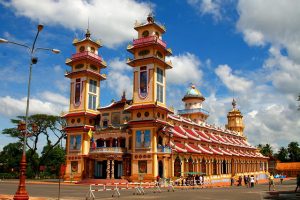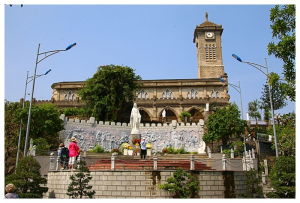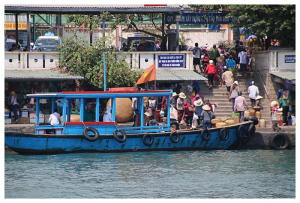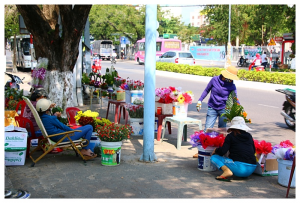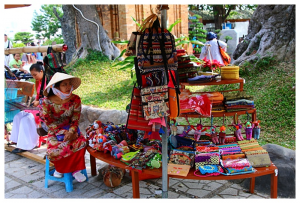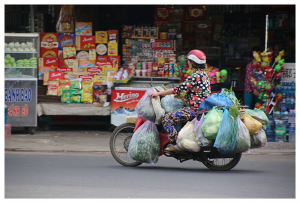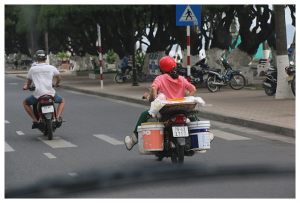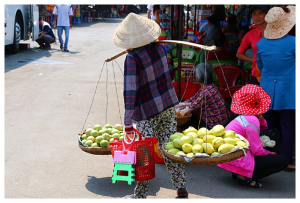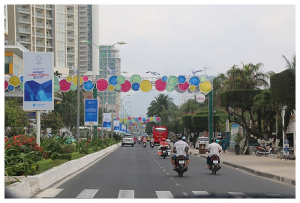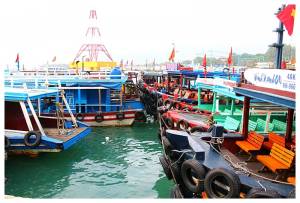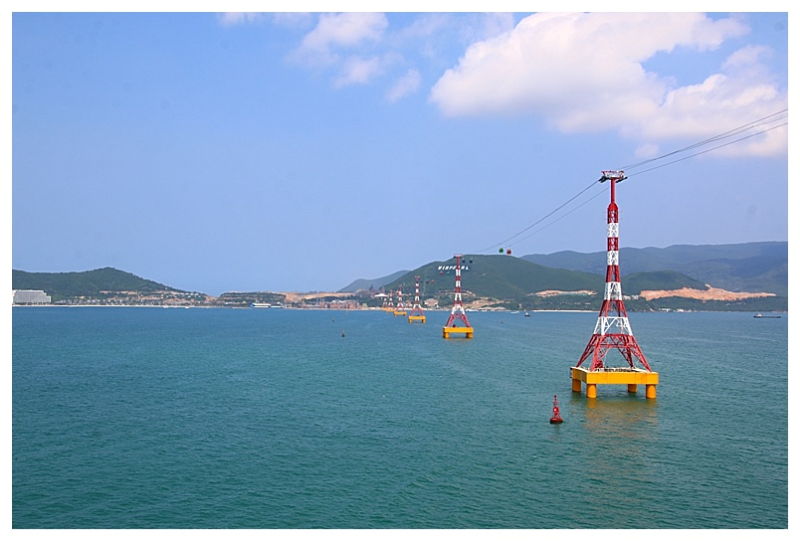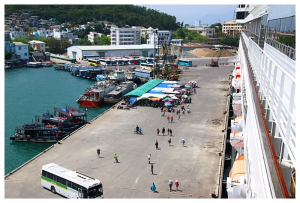 Vietnam was a dramatic shift from Hong Kong. There is a non-scientific term for a psychological state that occurs when something that happened in the past affects you in the present. The term is “emotional baggage.”
Vietnam was a dramatic shift from Hong Kong. There is a non-scientific term for a psychological state that occurs when something that happened in the past affects you in the present. The term is “emotional baggage.”
As a citizen of the United States and as a family member, I am still carrying emotional baggage about Viet Nam. As a citizen, I reflect back on news coverage and the frantic evacuations that took place as Saigon fell into the hands of the Communists. As a family member, I reflect back on the terrible morning almost 50 years ago when my father died of a heart attack.
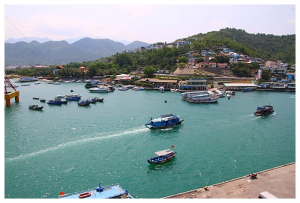
My Parents and I had driven from San Diego to Annapolis, Maryland to celebrate “June Week” and see my brother, Peter, graduate from the United Sates Naval Academy. This was going to be extra special for my father since his own graduation from the Academy in 1934 marked the beginning of a very successful Naval career.
We arrived late on Friday evening. Saturday morning my father began suffering chest pain and difficulty breathing. He died of a heart attack in an ambulance on the way to the Naval Academy Infirmary.
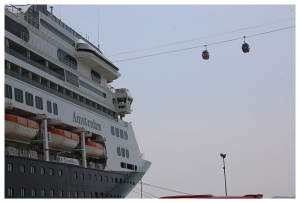
Mom and I remained in Annapolis for the rest of June Week and attended the graduation ceremony. The family vacation the four of us were planning to enjoy before Peter would report to his first assignment, was replaced by a flight back to San Diego and funeral arrangements.
Peter was the first in his Naval Academy class to be sent to Vietnam. This was a tumultuous time in American history. I remember President Johnson addressing the nation with a speech which he started by saying “why Vietnam?” I do not recall his answer to that question. He may have proposed an idea called “the dominoes theory.” Basically, that theory was that if South Vietnam fell into the control of the Communists the rest of the countries in southeast Asia would all fall like a line of dominoes.
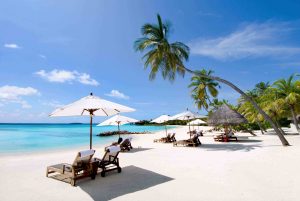
I remember the protests, the draft lottery, the young men who fled to Canada and the rising death count. I remember the unhappiness the members of the military felt towards Jane Fonda who was speaking out in a way that sounded like she was siding with the enemy.
My brother, Peter is a civil engineer. (He is also a computer genius but that happened much later.)The particular branch of the Navy in which Peter served is called “Sea Bees.” I would like to think that some of the structures his battalion built still exist and benefit the people of Vietnam today.
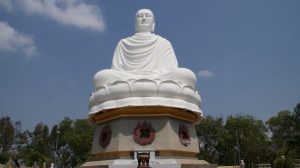
Peter served two tours of duty in Vietnam. Upon his return, he was not spat upon as some of our service men were, but he certainly experienced the total lack of appreciation which many Americans were showing toward Vietnam Veterans. Peter completed a successful active duty career in the Navy and then continued as a reservist.
I believe we are still suffering the consequence of the war in Vietnam. There was a terrible death toll on both sides, military and civilian. There are physical injuries which would have killed in previous wars, but due to improved evacuation procedures and medical advancements, left men maimed for life. There are the psychological injuries that participation in war brings to some. There is the problem of drug addiction that continues to disable men to this day. Many soldiers’ introduction to substance abuse took place in Vietnam. There are unanticipated physical consequences being experienced by Vietnam veterans today because of exposure to Agent Orange.
There are pathetic looking men standing on San Diego road medians holding cardboard signs proclaiming they are homeless, hungry begging for money. The signs say they served in Vietnam. The national suicide rate of veterans is reportedly 22 per day.
I think, with this amount of personal “baggage,” there is nothing good I might say about Vietnam. I must acknowledge, however, that life goes on.
I have friends who were refugees from that terrible conflict. They barely escaped with their lives. They started out in what was our own version of a refugee camp at Camp Pendleton and, with the help of many caring Americans, became integrated into our communities. These friends have recovered from the trauma to lead happy productive lives in the United States. They have become citizens. They have prospered enough to afford taking cruises such as the one I am on to visit their former homeland.
One of the listed shore excursions, which I did not take, gave an interesting explanation for the victory of the guerrilla fighters from the north. The tour was to the “Cu Chi Tunnels.” I will quote part of the description of these tunnels and the importance they played in wars.
“This tour focuses on the ingenuity and resilience of the Vietnamese fighters who both lived and fought from underground tunnels. Originally constructed as a means to fight against the French by the Viet Minh, the tunnels were later expanded up to 36 feet below ground in hard soil using only rudimentary tools. Most tunnels were only 2-2 ½ feet wide and 4 ½ feet tall, with thick roofs capable of withstanding the weight of tanks or the impact of bombs…underground meeting rooms, kitchens, hospital and sleeping areas.” There was over 150 miles of tunnels!
I have written enough about the impact of the Vietnam War. I will now tell about our excursions. Overall, we experienced great weather and saw beautiful beaches and countryside. We visited two different ports in Vietnam. The first was Nha Trang. In the course of our tour in this city, we visited several Buddhist temples including one which had a giant white statue of Buddha.
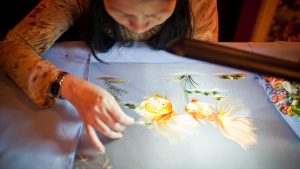
One of the final places we visited on our first day in Vietnam was a silk embroidery showroom. From a distance, the pictures on fabric looked like really nice line drawings but in reality the lines were all made of silk thread. It was quite surprising and quite pretty.
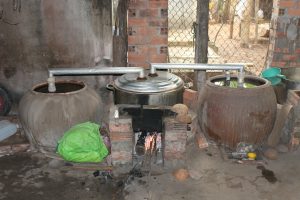
Our second port was Phu My. We chose to visit a small local community while others on the ship took a long trip to Ho Chi Minh City which as previously called Saigon, The community we visited was called Ba Ria, we were given the unusual opportunity to see rice wine distilled. It turns out to have a significant alcohol content! This was being produced by one family as a sort of “cottage industry.”
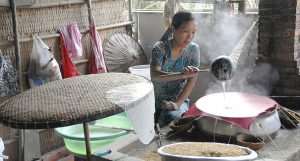 We visited another home were rice paper was produced. Both of these visits were to private homes which I found fascinating. Could you imagine running a little business out of your home and having busloads of tourists come through? The excursion information emphasized the importance of altars for ancestor worship within the homes; It reminded me of how we usually have pictures of our parents somewhere in our homes.
We visited another home were rice paper was produced. Both of these visits were to private homes which I found fascinating. Could you imagine running a little business out of your home and having busloads of tourists come through? The excursion information emphasized the importance of altars for ancestor worship within the homes; It reminded me of how we usually have pictures of our parents somewhere in our homes.
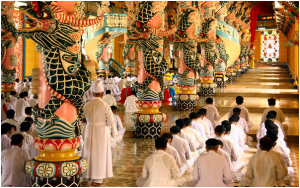
Since I spent some time at the start of this message reflecting about the Vietnam war, I thought I would do a little reflecting at the end about religions. One of the places we visited was a Cao Dai temple where a variety of religions were combined into one in an effort to create an ideal religion. This combining effort took place in 1926. It was a fusion of secular and religious philosophies of east and west. Cao Daism is a combination of Buddhism, Confucianism, Taoism, Hinduism, native Vietnamese spirits, Christianity and Islam. Somehow, this made me glad I was raised Catholic and I am sticking with it.
